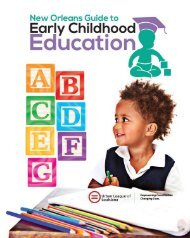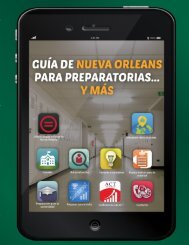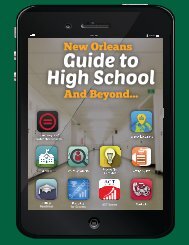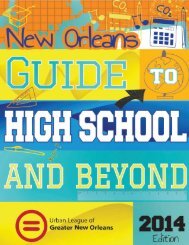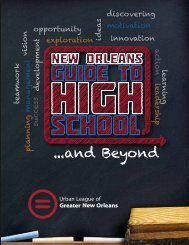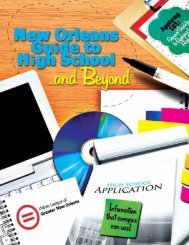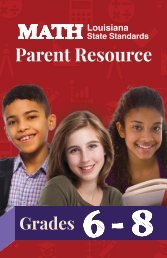New Orleans Guide to High School and Beyond 2018
Create successful ePaper yourself
Turn your PDF publications into a flip-book with our unique Google optimized e-Paper software.
COST<br />
The most significant difference between public <strong>and</strong> nonpublic schools<br />
is the cost. Public schools must be free <strong>and</strong> open <strong>to</strong> the public, while<br />
private schools can charge tuition. However, keep in mind that there<br />
may be cost associated with both types of schools. While public schools<br />
do not charge tuition, there may be a fee for transportation or you<br />
may be responsible for arranging transportation for yourself. The<br />
average cost of receiving a private or Catholic education at some<br />
of the more modest priced schools can run $5500 <strong>to</strong> $10,000 per<br />
year. There are several schools in the city where tuition runs well<br />
over $15,000 per year. However, do not let the cost of attending a<br />
nonpublic school s<strong>to</strong>p you from including it as an option, as many<br />
schools offer a variety of financial assistance opportunities.<br />
DEMOGRAPHICS<br />
You may want <strong>to</strong> consider the racial <strong>and</strong> ethnic makeup of the student<br />
body at the high schools you are considering. This information will<br />
tell you the percentage of students of each race or ethnicity who are<br />
currently enrolled at the school. The gender <strong>and</strong> socio-economic<br />
status of students attending the school may also be considered when<br />
evaluating diversity demographics. While this data does not mean<br />
a school is good or bad, it helps in determining whether or not a<br />
student is able <strong>to</strong> adapt or thrive in a different setting.<br />
DISCIPLINE MODEL<br />
Every school has a different approach <strong>to</strong> discipline <strong>and</strong> classroom<br />
management. These differences make a significant impact on a<br />
school’s culture. Some rules, consequences, <strong>and</strong> procedures may be<br />
more or less effective depending on the student’s personality. A school<br />
with weak or ineffective rules <strong>and</strong> discipline policies may make it<br />
difficult <strong>to</strong> be as productive a student as possible. However, policies<br />
that appear <strong>to</strong>o rigid or strict may also impact a student's ability <strong>to</strong><br />
be successful. Ask about the school’s rules <strong>and</strong> policies on suspension,<br />
detention, etc. Some schools are implementing res<strong>to</strong>rative justice<br />
approaches <strong>and</strong> creative alternatives like meditation. When you<br />
visit, notice how other students are behaving. Ask yourself, “Is it an<br />
atmosphere conducive <strong>to</strong> my learning?”<br />
EXTRACURRICULAR<br />
ACTIVITIES AND ATHLETIC<br />
PROGRAMS<br />
While academics are critical when choosing a high school,<br />
extracurricular activities <strong>and</strong> athletic programs are important as<br />
well. If you have a particular interest, such as b<strong>and</strong>, drama, student<br />
government, etc., try <strong>to</strong> find a school where these activities are<br />
available. Likewise, if you really want <strong>to</strong> participate in baseball,<br />
football, track, or swimming, try <strong>to</strong> find a school that supports these<br />
programs. It is important that you become involved in activities during<br />
your time in high school because many colleges <strong>and</strong> universities take<br />
this in<strong>to</strong> consideration when reviewing a student's application for<br />
admittance. Also, colleges <strong>and</strong> universities often award scholarships<br />
for specific extracurricular or athletic abilities.<br />
FACILITIES (AGE, LAB, LIBRARY,<br />
AND OTHER AMENITIES)<br />
Both the environmental <strong>and</strong> educational conditions of a facility say<br />
a lot about a school. <strong>School</strong> facility fac<strong>to</strong>rs such as building age,<br />
condition, quality of maintenance, temperature, lighting, noise,<br />
color, <strong>and</strong> air quality can affect student health, safety, psychological<br />
state, sense of pride in the school, <strong>and</strong> education received. You<br />
want <strong>to</strong> make sure the facility is adequately equipped <strong>to</strong> meet your<br />
educational needs. For example, if you are interested in a rigorous<br />
science curriculum, consider whether or not the school has high quality<br />
Biology <strong>and</strong> Chemistry labs. If you are interested in sports, consider<br />
the quality of the baseball gym, football field, etc.<br />
If you want <strong>to</strong> attend a technology rich school, consider whether the<br />
school has a media or computer center with wireless Internet access,<br />
<strong>and</strong> if you want <strong>to</strong> attend an Arts-focused school, consider the quality<br />
of the theater room, music room, musical instruments, etc. Other<br />
fac<strong>to</strong>rs <strong>to</strong> consider include physical classroom attributes (i.e. size<br />
<strong>and</strong> lighting), if there is a comfortable study area, <strong>and</strong> if there is a<br />
library, as well as the number of books in the library.<br />
GPA<br />
<strong>School</strong>s may report the average GPA (Grade Point Average) of their<br />
student body. Likewise, every student has their individual GPA based<br />
on their grades in class. Students are awarded points on a scale (i.e.<br />
A=4, B=3, C=2, D=1, F=0). Points are given for each grade they<br />
receive; all the points are added <strong>to</strong>gether, <strong>and</strong> the <strong>to</strong>tal is divided by<br />
14





